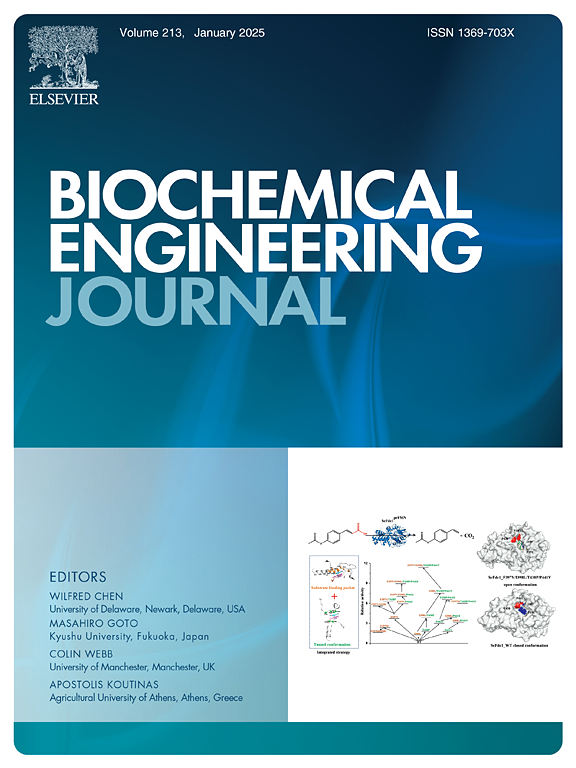Effect on bioenergy production through optimization of electrokinetically assisted anaerobic co-digestion of petrochemical industry sludge and lignocellulosic waste: A pathway through hydrocarbon and lignin degradation
IF 3.7
3区 生物学
Q2 BIOTECHNOLOGY & APPLIED MICROBIOLOGY
引用次数: 0
Abstract
Petroleum refinery biological sludge (PB), generated from the effluent treatment plants of petrochemical refining industries, poses a substantial hazard to environment due to its complex hydrocarbon composition, warranting its meticulous management and disposal. This study advocates a sustainable approach through anaerobic co-digestion, integrating petroleum refinery biosludge (PB) with lignocellulosic yard waste (YS) for balance of nutrient and moisture content leading to enhanced biodegradation. The co-digestion of PB with YS was assessed for improvement in anaerobic biodegradability through electrokinetic process, which when optimized at an applied voltage of 53.5 V for 53 min using Central Composite Design-Response Surface Methodology, led to the improvement in solubilization of PB mixed with YS at carbon/nitrogen ratio of 32.5 and pH of 7.0. Optimization of batch anaerobic biodegradability assay conducted at different inoculum and pretreated substrate (I/F) ratios (0.3, 0.4, 0.5, 0.7) resulted in maximal biogas at I/F= 0.4 with net energy gained by 35.5-fold that of the invested energy. Upscaling the batch studies led to 84.2 % enhancement in biogas production compared to monodigeston of PB with significant hydrocarbon content, emulsion, and lignin degradation establishing a synergistic and sustainable technique in the overall management of PB.
通过优化电动辅助厌氧共消化石化工业污泥和木质纤维素废弃物对生物能源生产的影响:碳氢化合物和木质素降解途径
石油炼化生物污泥是石油化工炼化废水处理厂产生的生物污泥,其烃类成分复杂,对环境造成严重危害,需要对其进行严格的管理和处理。本研究提倡一种可持续的方法,通过厌氧共消化,将石油炼油厂生物污泥(PB)与木质纤维素废弃物(YS)整合,以平衡营养和水分含量,从而增强生物降解。研究结果表明,在53.5 V、53 min的施加电压下,采用中心复合设计-响应面法优化后,在碳氮比为32.5、pH为7.0的条件下,PB与YS共消化对厌氧生物降解性的改善效果显著。在不同的接种量和预处理底物(I/F)比(0.3、0.4、0.5、0.7)下对间歇式厌氧生物降解试验进行优化,得到的最大沼气在I/F= 0.4处,净能量是投入能量的35.5倍。与单消化PB相比,扩大批量研究使沼气产量提高了84.2 %,同时具有显著的烃含量、乳化液和木质素降解,为PB的全面管理建立了协同和可持续的技术。
本文章由计算机程序翻译,如有差异,请以英文原文为准。
求助全文
约1分钟内获得全文
求助全文
来源期刊

Biochemical Engineering Journal
工程技术-工程:化工
CiteScore
7.10
自引率
5.10%
发文量
380
审稿时长
34 days
期刊介绍:
The Biochemical Engineering Journal aims to promote progress in the crucial chemical engineering aspects of the development of biological processes associated with everything from raw materials preparation to product recovery relevant to industries as diverse as medical/healthcare, industrial biotechnology, and environmental biotechnology.
The Journal welcomes full length original research papers, short communications, and review papers* in the following research fields:
Biocatalysis (enzyme or microbial) and biotransformations, including immobilized biocatalyst preparation and kinetics
Biosensors and Biodevices including biofabrication and novel fuel cell development
Bioseparations including scale-up and protein refolding/renaturation
Environmental Bioengineering including bioconversion, bioremediation, and microbial fuel cells
Bioreactor Systems including characterization, optimization and scale-up
Bioresources and Biorefinery Engineering including biomass conversion, biofuels, bioenergy, and optimization
Industrial Biotechnology including specialty chemicals, platform chemicals and neutraceuticals
Biomaterials and Tissue Engineering including bioartificial organs, cell encapsulation, and controlled release
Cell Culture Engineering (plant, animal or insect cells) including viral vectors, monoclonal antibodies, recombinant proteins, vaccines, and secondary metabolites
Cell Therapies and Stem Cells including pluripotent, mesenchymal and hematopoietic stem cells; immunotherapies; tissue-specific differentiation; and cryopreservation
Metabolic Engineering, Systems and Synthetic Biology including OMICS, bioinformatics, in silico biology, and metabolic flux analysis
Protein Engineering including enzyme engineering and directed evolution.
 求助内容:
求助内容: 应助结果提醒方式:
应助结果提醒方式:


